Counter strike on states
After the famous September 11 incident, when Arab terrorists sent captured airliners to the towers of the World Trade Center in New York and the Pentagon building, they started talking in the United States that their country was not ready to repel an air attack. At the same time, the Yankees for some reason forgot about the tragedy in Pearl Harbor and the unusual events of 1942.
And in the autumn of that year, the population of the states located in the “Wild West” was unpleasantly surprised to hear from the radio and from the newspapers about the fires breaking out in different places. The time was military, and reporters declared the culprits of German and Japanese saboteurs. And then something completely incomprehensible happened - fires continued to arise, and the messages about them disappeared. The fact that what was happening in the States in fact became known only after the Second World War.
It all started in December 1941 on the Japanese submarine I-25, which was in a military campaign off the coast of the United States. In a conversation with Lieutenant Tsukuda, the pilot of the onboard seaplane Nabuo Fujita noticed that it would be nice if the submarines equipped with the aircraft would approach the US, launch the seaplanes into the water, and the pilots would attack the naval bases, the ships and the ships in them structures. The aircraft carriers sent to the similar mission with the Yankee ships guarding them will surely find and try to do everything so that the attack attempt does not go unpunished, and the boats could approach the coast covertly.
After the return, the report written by Fujita and Tsukuda went to the authorities, and soon the pilot was summoned to headquarters. There he presented his plan to senior officers. By the way, they have already received similar offers from sea aviators. The idea was approved, and the execution was entrusted to Fujita himself, who, having flown 4 in thousand hours, was considered quite experienced and suitable for so risky the south of the enterprise. Only the bases and industrial enterprises were to be bombed, but the forests of the state of Oregon. As Fujite explained, two high-explosive bombs weighing 76 kg, which can lift his plane, will not harm ships and factories, and the extensive forest fires caused by them will cause panic attacks over enemy cities.
15 August 1942 I-25 left the base in Yokosuka on a trip and September 1 approached Oregon. On September 9, the commander of the ship, Capt. 3 of rank M. Tagami summoned Fujitu to the conning tower and ordered him to look through the periscope on the coast.
And-25 surfaced, a hydroplane removed from the hangar and put on a catapult. Fujita and the observer Okuda donned coveralls, climbed into the cabin and were soon in the air. Fujita headed for the lighthouse at Cape Blanco, crossed the coast line and headed north-east. “The sun was already gilding the clouds when, after flying 50 miles (about 100 km.), I ordered Okud to drop the first bomb, and after 5-6 the second one - recalled Fujita. - The bright flame marked the explosions of our bombs, and there was already smoke coming from the first place. Four months ago, US aircraft bombed my land for the first time, now I have bombed their territory. ”
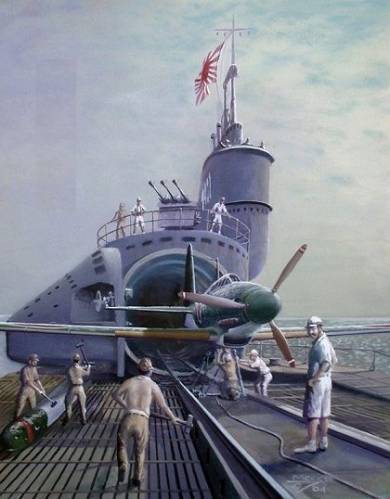
Down to 100, Fujita flew to the ocean. Having noticed two vessels, he pressed himself against the water so that they could not see his identification marks, the red circles on the wings. Having found the 25, the hydroplane splashed down, and the pilots reported to Tagami about the flight and the ships. He decided to attack them, but enemy planes appeared, and I had to urgently plunge. "Fortune was again gracious to us, all day we heard the explosions of depth charges and noises of destroyers sent to hunt for us," continued Fujita, "but all this happened far away, and the explosions did not touch the boat."
On the night of September 28 Tagami surfaced, the plane was prepared, and Fujita again went to visit the United States. Focusing on a compass and working in spite of wartime, the lighthouse on Cape Blanco, he crossed the coastal strip and headed deep into the mainland. Let us again give the floor to the Japanese pilot: “Having flown half an hour, we dropped the second pair of 76-kilogram bombs, leaving two hot spots on the ground. The return was alarming: we reached the rendezvous point With the boat, but I didn't find X-NUMX. Perhaps she was already drowned, or maybe Tagami was forced to leave. ” Fortunately, circling over the ocean, the pilots noticed rainbow spots on its surface, probably traces of diesel fuel from the submarine. Having flown from one spot to another, they finally saw an E-25. A few minutes later the hydroplane was in the hangar, and Fujita reported to the commander about the adventures.
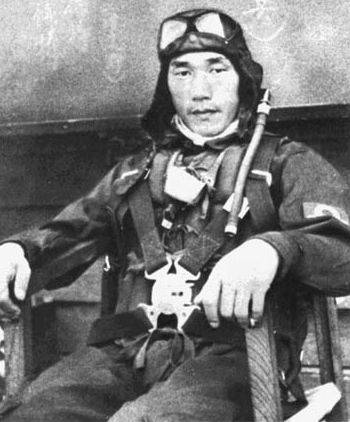 Michman Nabuo Fujita - the only Japanese pilot to bomb the US territory
Michman Nabuo Fujita - the only Japanese pilot to bomb the US territoryThere were two more “lighters”, and the pilots were eager for the next flight, along Tagami headed for Japan. Having sunk two tankers, he believed that the command of the Pacific fleet The United States has already sent anti-submarine ships and aircraft in search of the Japanese submarine, so you should not linger in the waters controlled by the enemy. At the end of October, the I-25 moored in Yokosuka.
And the aerial attack on the US continued - seemingly unreasonable fires flared up in the states of Washington and California, moreover, where fire sabotage was meaningless - in deserted places, mountains and deserts. To them, as it is not surprising, the Japanese pilots had nothing to do with. It turns out that the fires were the result of the operation of Fu-Guo, started by Lieutenant-General Kusaboy. On his orders, the Japanese launched 10 thousand balloons from the Japanese islands in the direction of the USA. They were picked up by air streams rushing from west to east at altitudes S - 12 thousand meters. Each ball carried a high-explosive igniter bomb weighing 100 kg, which was discharged by a clock mechanism driven by a certain flight time (range). While the US radio and press reported where strange fires occurred, Kusaba could correct the launches of flying saboteurs, but the US intelligence services thought of it and told them to stop talking and writing about fire geenna, and the Japanese had to release balloons at random. Therefore, they flew wherever they wanted, for example, to Mexico and Alaska, and one flew even near Khabarovsk. The territory of the United States reached about 900 balls, that is, approximately 10% of the total number of running.
The fate of the participants of the bomber I-25 campaign was different. The submarine itself is already with another commander, 12 June 1943 was tracked down by the US destroyer Taylor near the Solomon Islands and sunk by its depth bombs. After the war, Japan was left without a navy, and M. Tagami became the captain of a merchant ship. Fujita at 1962 visited Brookings in Oregon, apologized to old-timers for the trouble caused at 1942, and handed money to buy books about Japan. In response, the city council declared him an honorary citizen. And on November 27, 1999, Japanese media reported the demise of an 84-year-old pilot - the only one who managed to bomb the US ...
Submarine raiders
N.Fudzita conceived an air attack on the United States as a response to their bombardment by Japanese aviation. However, the aggressors were still his countrymen. 7 December 1941 almost two hundred aircraft that took off from the aircraft carrier of the imperial fleet, without declaring war attacked the US Navy base in Pearl Harbor on the Hawaiian Islands. At the same time, five ultra-small submarines attempted to enter her harbor. The operation was a success - Japanese pilots sank four battleships, a minelayer, a self-propelled target, a former battleship, and wrecked the three cruisers, the same number of destroyers and a gidroaviatrapeport, destroyed the 92 naval and 96 army combat aircraft, 2117 mariners, 194 armies and armies destroyed the army, 57 army armies, 29 and XNUMX army combat aircraft killed, XNUMX seafarers killed, XNUMX armies killed XNUMX army combat aircraft. The Japanese lost XNUMX bombers, torpedo bombers and fighters and five ultra-small submarines.
The United States decided to take revenge and arrange a demonstration raid on Japan. 18 April 1942 from the aircraft carrier Horvet, located 700 miles from the Land of the Rising Sun, took off 16 army bomber B-25 Mitchell, Lieutenant Colonel D. Dulitt, each had 2,5 tons of bombs. They were dumped in the districts of Tokyo, shipbuilding, military, oil refineries, power plants of the capital, Kobe, Osaka and Nagoya. Since the army pilots did not know how to land on aircraft carriers, then, “unloading”, they headed west to take seats in areas of China that were not occupied by the Japanese. Five cars got there, one landed near Khabarovsk, on the ground non-military in the Far East of the Soviet Union. The rest, having consumed fuel and because of injuries, eight pilots who jumped with parachutes over Japan fell into the Sea of Japan, valiant samurai beheaded.
So in terms of the size and results of the operation undertaken by Fujita and Tagami, there is no comparison with the American raid on Tokyo. By the way, if the people of the United States knew who the arsonists were, their hatred of the "Japs," as they scornfully called the Japanese, would only have intensified.
In fact, the idea of striking the enemy’s territory from submarines was correct - for this purpose modern submarine-carrying submarines were intended, but carried out by insignificant forces and weak means. However, there were no others then.
In World War I, air transport showed itself well, from which hydroplanes, reconnaissance aircraft and bombers were launched, and after the flight they were taken aboard. In 20-s. in England, the United States, France and Japan began to build aircraft carriers, from the spacious landing deck which flew airplanes with a wheeled chassis, on the battleships and cruisers installed catapults to launch hydroplanes reconnaissance and spotters artillery fire.
We tried to "prescribe" aviation and submarines. Next to the conning tower, they arranged a hangar with a hermetic door, in which they held a seaplane with folded wings, and on the upper deck they arranged a catapult that accelerated its takeoff. After landing near the boat, the Aircraft was raised with a crane, folding its wings and cleaning up the hangar. This was the English M-2, which was turned into an aircraft carrier in 1927, and in the next it did not return to base. As the divers who found it found it, the crash occurred due to the hangar door that was not tightly closed by the crew, through which the boat was flooded with sea water.
One seaplane placed on other submarines. In 1920-1924 in the USA, on ships of type C, then on three types of “Barracuda” with a displacement of 2000 / 2500 t, in 1931 g, in the Italian “Ettori Fieramoska” (1340 / 1805 t) and Japanese I-5 (1953 / 2000 t). Otherwise, the French arrived in 1929 with the submarine “Surcouf” (2880 / 4368), which should have defended their convoys and attacked others. The airborne reconnaissance seaplane was supposed to direct the enemy Surkuf armed with 14 torpedo tubes and two powerful 203 mm caliber guns. Later, the Japanese equipped with one or two planes another three dozen submarines, including the one mentioned by the I-25.
Note that the weight of the aircraft under the boat-based were light reconnaissance - large submarines did not fit.
But in World War II, submariners abandoned aerial exploration. When preparing onboard seaplanes for flight and taking on board, the ship had to remain on the surface, substituting itself for the blows of the enemy. And then there was no need for them, because more effective radars appeared.
As for the operation of Fu-Go, the launch of thousands of uncontrollable balls with a favorable wind was like shooting from a machine gun with closed eyes - perhaps something will disappear somewhere ...
However, the USA used the Japanese experience in 60-s, launching balloons into the airspace of the USSR with photos and other reconnaissance equipment. Some of them landed at us, and the “payload” was taken over by Soviet specialists, many were shot down by fighters, many after long wanderings at the will of the winds disappeared or were shot not what was needed. Therefore, the United States began to send reconnaissance aircraft to the territory of the Soviet Union, but after the scandal with U-2, they were forced to abandon this method of obtaining specific information.
As for the Japanese, in 1942 they conceived a strategic operation that promised to turn into substantial material losses for the USA and would deprive them of the ability to maneuver the forces of the fleet between the Pacific Ocean and the Atlantic. It was a massive strike on the Panama Canal, which 10 bombers and torpedo bombers, which launched from submarines of the huge 3930 tonnings at that time, had to launch, - 122 m long, eight torpedoes, eight torpedoes. vehicles, a hangar for three aircraft and a catapult. The supply of fuel was envisaged for overcoming about 140 thousand miles.
By December 1944, the head I-400 was ready, and the 401 and 402 were completed. In addition to them, in January and February 1945, but two aircraft were placed on the I-13 and I-14, the commander of the strike group was appointed captain 3 of the rank Aridzumi. For training, the pilots built models of the locks of Panama Kapala - they were going to drop at least six torpedoes and four bombs to the real ones.
But the war ended, 16 June aircraft from US aircraft carriers sank I-13, and 16 in August, Emperor Hirohito ordered the armed forces to cease hostilities. Aridzumi shot himself.
Both 400 and I-401 became US trophies, and the unfinished I-402 was converted into a tanker.
The mysterious episode of the war in the Pacific Ocean is connected with the “bomber” campaign I-25. Referring to the words of Tagami, another Japanese submariner, M. Hashimoto wrote that when returning home "in early October, I-25, with only one torpedo, attacked and sank the American submarine."
It happened west of San Francisco. And the US Navy officer E. Beach, who fought on submarines, in the preface to the translation of the book, Hashimoto claimed that "Tagami was mistaken in time, it would be better to say that he sank the American submarine at the end of July." He was referring to “Grunion”, which last contacted the July 30 base when she was in a position north of the Aleutian Islands. Yes, and Tagami could hardly be mistaken for more than two months, telling Hashimoto about the campaign immediately after returning.
In 1942, the belligerent Northern Fleet decided to strengthen the Pacific ships. The surface ships went along the Northern Sea Route, and the submarines went across the Pacific Ocean, the Panama Canal, the Atlantic, around Scandinavia to the Polar Sea. October 11 with a submarine minelayer L-15 saw how a column of water and smoke flew over the head of L-16, and the boat disappeared under water. With L-15 noticed the periscope and managed to fire at him. Up to San Francisco, 820 miles remained. It is hardly possible to talk about evil intent. Tagami did not know about the transition of the Soviet submarines, which, of course, kept a secret, and these our submarines had the misfortune to be like American ones, such as C ...
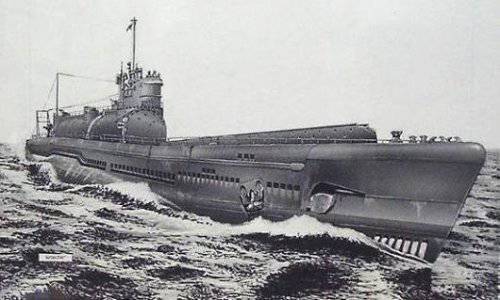
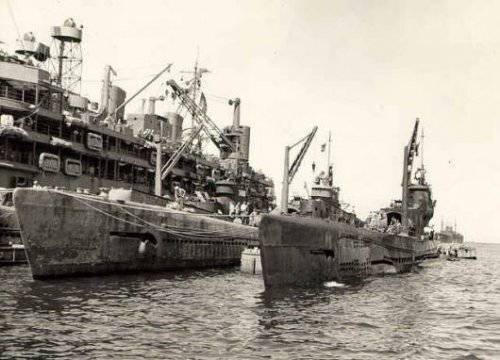
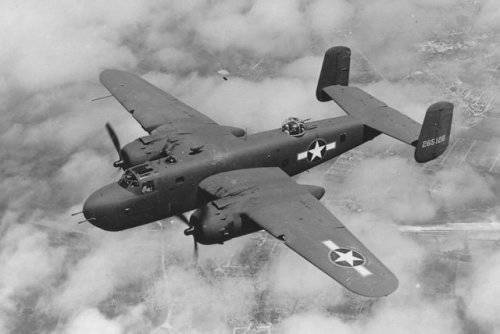
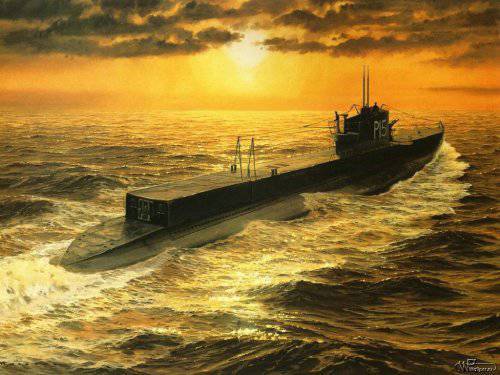
Information